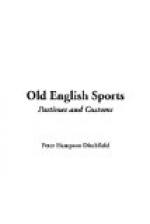“But he was an archer
true and good,
And people called him
Robin Hood;
Such archers as he and
his men
Will England never see
again.”
Another ballad relates the prowess of William of Cloudslee, who scorned to shoot at an ordinary target, and cutting a hazel rod from a tree, he shot at it from twenty score paces, cleaving the rod in two.
[Illustration: Cross-bow shooting at the butts (from Ms. dated 1496).]
[Illustration: An archer.]
Like William Tell of great renown, our English archer could split an apple placed on his son’s head at the distance of six score paces.
In time of war the archers were armed with a body-armour, the arms being left free. They had a long bow made of yew, a sheaf of arrows winged with gray goose-feathers, a sword, and small shield. Such was the appearance of the men who struck such terror among the knights and chivalry of France, and won many victories for England before the days of muskets and rifles.
We are now in the season of Lent, and our towns and villages were very still and quiet during these weeks. But there was an old custom on Refreshment[7] or Mid-Lent Sunday for people to visit their mother-church and make offerings on the altar. Hence probably arose the practice of “mothering,” or going to visit parents on that day, and taking presents to them. Herrick alludes to this pleasant custom in the following lines—
“I’ll to thee
a simnell bring,
’Gainst thou go’st
a mothering;
So that when she blesseth
thee,
Half that blessing thou’lt
give me.”
Many a mother’s heart would rejoice to welcome to the old village home once again some fond youth or maiden who had gone to seek their fortunes in the town, and many happy recollections would long linger of “Mothering” Sunday. The cakes alluded to in the above verse, which children presented to their parents on these occasions, were called Simnells. In some parts of England—in Lancashire, Shropshire, and Herefordshire—these cakes are still eaten on Mid-Lent Sunday. Possibly they had some religious signification, for the Saxons were in habit of eating consecrated cakes at their festivals. The name Simnell is derived from a Latin word signifying fine flour, and not from the mythical persons, Simon and Nell, who are popularly supposed to have invented the cake. Hot cross buns are a relic of an ancient rite of the Saxons, who ate cakes in honour of the goddess of spring, and the early Christian missionaries strove to banish the heathen ideas associated with the cakes (which latter the people would not abandon) by putting a cross upon them.




